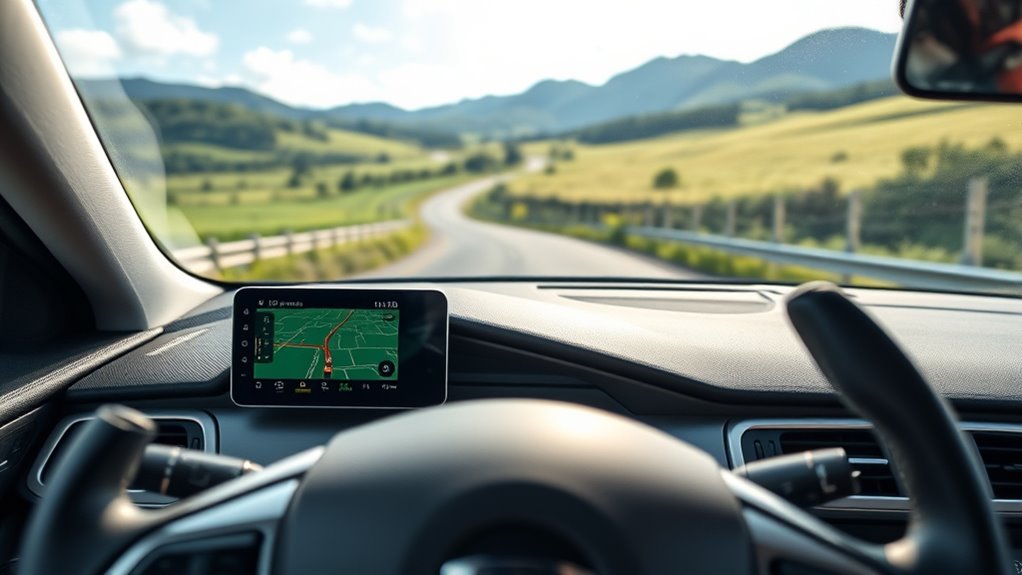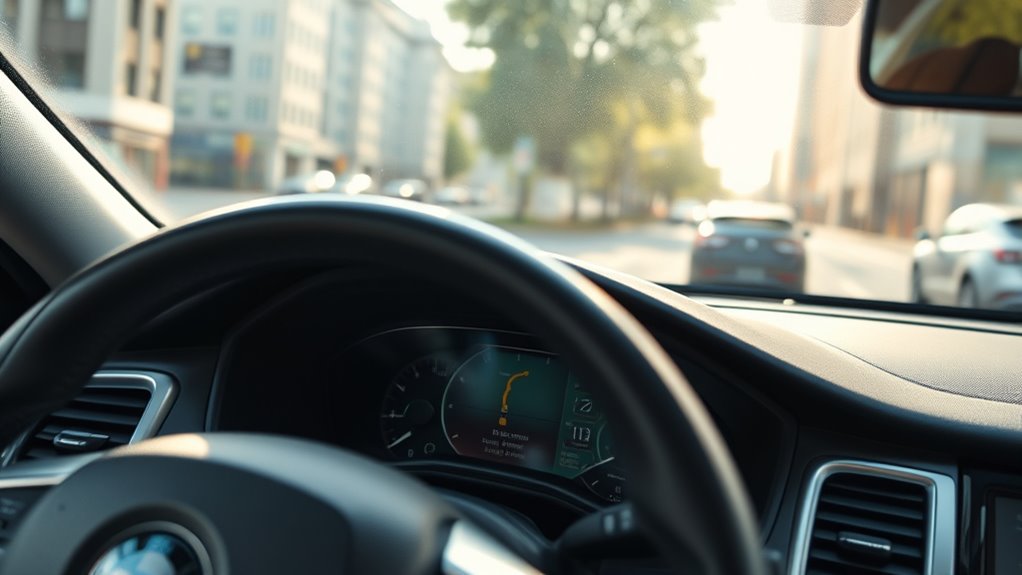To maximize deductions, use the IRS mileage rate—currently 58.5 cents per mile for the first half of the year and 62.5 cents for the second—to capture all qualifying miles like client visits and supply runs. Pair this with automatic mileage tracking apps that GPS your trips, make recordkeeping easy, and guarantee accuracy. Staying organized prevents costly mistakes and boosts your savings. Keep going to uncover expert tips that make mileage deduction even simpler and more effective.
Key Takeaways
- Use the IRS 70-cent mileage rate to maximize deductions for all qualifying gig-related driving expenses.
- Keep accurate, detailed logs of each trip to ensure IRS compliance and claim the full mileage deduction.
- Automate mileage tracking with GPS apps to reduce errors and simplify recordkeeping.
- Track only miles driven for business purposes, excluding personal commuting, to avoid deduction errors.
- Regularly update and review mileage records to prevent mistakes and optimize your tax savings.
Maximize Your Deduction With the 70-Cent Mileage Rate

Maximizing your tax deduction is straightforward when you use the IRS’s 70-cent mileage rate for 2025. This rate covers not just fuel but also vehicle maintenance, insurance, depreciation, and other costs. By tracking the miles you drive for business, you can claim a deduction up to this limit, helping reduce your taxable income. Remember, the deduction applies only to miles driven for qualifying purposes, such as client visits or supply runs. Keep detailed logs to support your claim, since the IRS emphasizes accurate recordkeeping. The 70-cent rate simplifies your recordkeeping compared to tracking actual expenses, but it’s essential to stay within deduction limits. Using this rate, your miles driven translate into significant savings, especially if you regularly commute for work-related tasks. Factors like inflation and rising fuel prices also influence the rate, making accurate mileage tracking even more valuable for gig workers. Additionally, understanding the deductible mileage can help you plan your routes more efficiently and maximize your deductions.
The Power of Automatic Mileage Tracking Apps
Tracking your mileage accurately is key to maximizing your tax deductions, and automatic mileage tracking apps make this process simpler and more reliable. Unlike manual logging, these apps use GPS to track your trips automatically, reducing errors and saving you time. You don’t need extra hardware requirements—most apps work seamlessly with your smartphone. They generate IRS-compliant reports, ensuring your mileage records are accurate and ready for tax season. Many apps also classify trips automatically and provide easy-to-read reports, making record-keeping straightforward. With features like cloud storage and multi-platform support, you can access your data anytime, anywhere. While some apps require a subscription for advanced features, the potential tax savings from precise tracking make the investment worthwhile. GPS-based tracking is considered highly accurate and is accepted by the IRS for mileage deductions.
Understanding Which Miles Qualify for Deduction

Understanding which miles qualify for deduction can seem complex, but the IRS has clear guidelines to help you determine eligible trips. Business miles include driving to meet clients, delivery routes, or between job sites. Trips for vehicle maintenance related to your gig work also qualify. Additionally, some beneficial ingredients like collagen and hyaluronic acid can enhance the effectiveness of eye patches. However, personal commuting from home to your regular workplace isn’t deductible. Here’s a quick overview:
| Trip Type | Qualifies? | Notes |
|---|---|---|
| Home to main work location | No | Personal commuting, not deductible |
| Client meetings, deliveries | Yes | Business-related trips |
| Running errands for business | Yes | Picking up supplies or tools |
| Vacation or personal travel | No | Not related to gig work |
Keep detailed logs to differentiate between qualifying and non-qualifying miles. Proper record-keeping is essential to ensure accurate deduction claims and compliance with IRS rules.
Strategies to Keep Accurate and Compliant Records

To make certain your mileage records stay accurate and compliant, it’s essential to adopt consistent and timely recordkeeping practices. This helps you avoid recordkeeping challenges and audit pitfalls. First, record mileage at or near each trip’s start and end to meet the IRS’s “contemporaneous” requirement. Second, update your logs at least weekly, ensuring all data remains current and accurate. Third, keep separate logs for personal and business miles to prevent confusion and potential audit issues. Use a consistent format—whether a paper log, spreadsheet, or app—to streamline data collection. Accurate records should include trip date, start and end locations, purpose, exact miles driven, and odometer readings. Leveraging technology like GPS apps simplifies compliance and reduces errors, making audits less stressful. Furthermore, maintaining detailed records helps substantiate your deductions during an IRS audit and ensures you maximize your mileage benefits.
How to Avoid Common Mistakes That Could Cost You

Mistakes in handling mileage deductions can lead to costly errors on your tax return. To avoid tax pitfalls, understand that mileage deductions lower your taxable income, not provide a direct refund. Choosing the wrong method, like switching between standard mileage and actual expenses, can reduce deductions or complicate record keeping strategies. Failing to track miles from the start may cause you to miss out on significant savings. Use apps or mileage logs to ensure accurate, compliant records. Properly understanding deduction impacts can help you make informed decisions. Here’s a quick comparison:
| Mistake | Consequence | Solution |
|---|---|---|
| Misunderstanding deduction | Overestimating income | Properly understand deduction impacts |
| Incorrect method choice | Leaving money on the table | Consistently track and choose the best method |
| Poor record keeping | Audit risk, lost deductions | Use reliable apps for detailed logs |
Staying vigilant helps maximize deductions and avoid costly tax pitfalls.
Frequently Asked Questions
Can Gig Workers Switch Between Standard Mileage and Actual Expense Deductions?
You can switch between standard mileage and actual expense deductions if you initially used the mileage rate in your first year and didn’t claim actual expenses then. This allows you to deduct vehicle maintenance, insurance costs, and other expenses more accurately. However, once you switch to actual expenses, you generally can’t go back to the mileage method without IRS permission, so track your miles and costs carefully to keep your options open.
How Does Electric Vehicle Depreciation Affect Mileage Deduction Calculations?
You might think electric vehicle depreciation impacts your mileage deduction, but surprisingly, it doesn’t. The IRS mileage rate for 2025 already includes depreciation schedules and electric vehicle incentives, making separate calculations unnecessary. This coincidence simplifies your taxes, allowing you to focus on tracking miles accurately. So, even with EV-specific depreciation concerns, the standard rate covers all costs, letting gig workers benefit without extra paperwork or complex depreciation adjustments.
Are Mileage Deductions Available for Personal Errands Unrelated to Gig Work?
You can’t claim mileage deductions for personal errands unrelated to gig work. The IRS strictly separates business-related mileage from personal errands, which are non-deductible. When tracking your miles, make sure to exclude trips for errands that don’t serve your gig, and keep detailed logs to support your claims. Including unrelated mileage could lead to audits or disallowed deductions, so stay diligent in documenting only the miles directly tied to your work.
What Documentation Is Required if I Get Audited on Mileage Claims?
When facing an audit, don’t leave anything to chance—be prepared with solid mileage verification. You’ll need detailed logs showing date, starting point, destination, and business purpose for each trip. Keep odometer readings at year’s start and finish, along with receipts for tolls and parking. Organize your audit documentation chronologically, so your records tell a clear story. This way, you’ll be ready to prove your mileage claims and stay one step ahead.
Is There a Maximum Number of Miles I Can Claim Annually for Deductions?
You might wonder if there’s a mileage cap or deduction limits for claiming miles on your taxes. The good news is, there’s no set maximum miles you can claim annually. However, only miles driven for qualifying purposes, like business or charity, are deductible. Keep detailed logs to support your deduction, and remember, claiming excessive miles without proper documentation could raise red flags with the IRS.
Conclusion
Think of the IRS mileage deduction as a secret treasure map—if you follow it carefully, you’ll uncover valuable savings. By using the 70-cent rate, tracking your miles automatically, and staying compliant, you’re steering your gig work with confidence. Avoiding common mistakes keeps you on the right path, ensuring you don’t miss out on what’s rightfully yours. Keep your records sharp, and watch your deductions grow like a well-tended garden—flourishing with effort.









